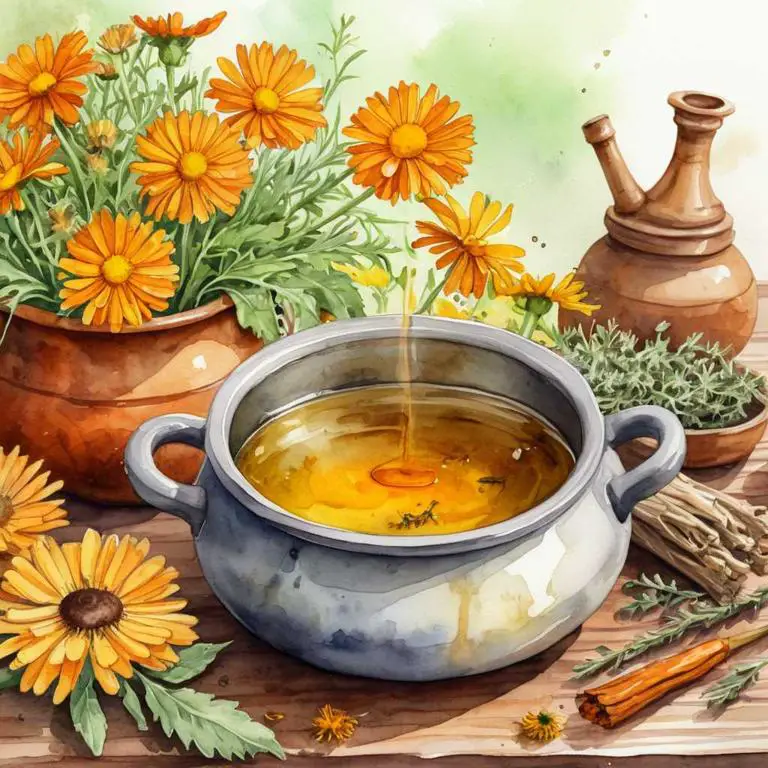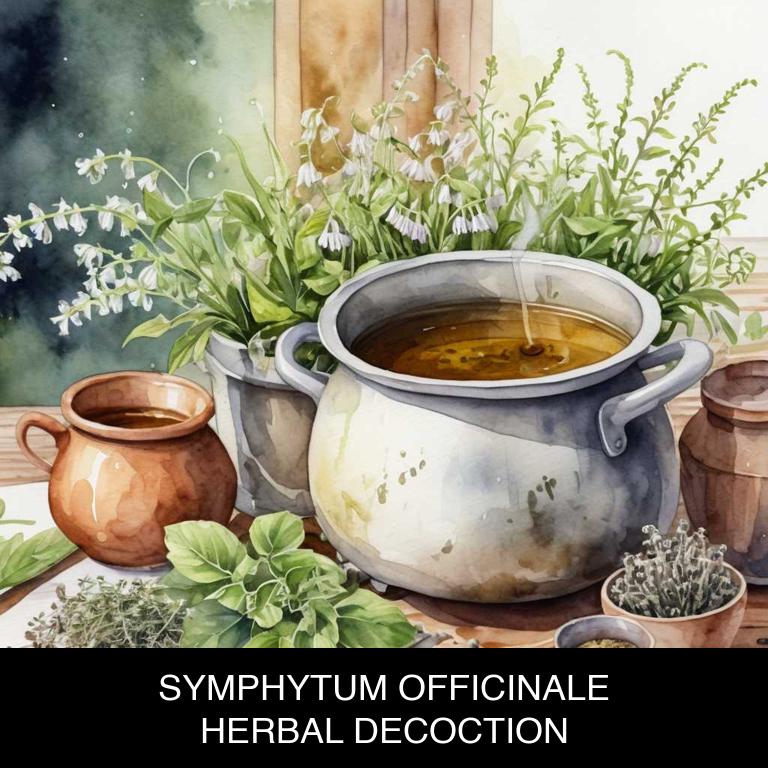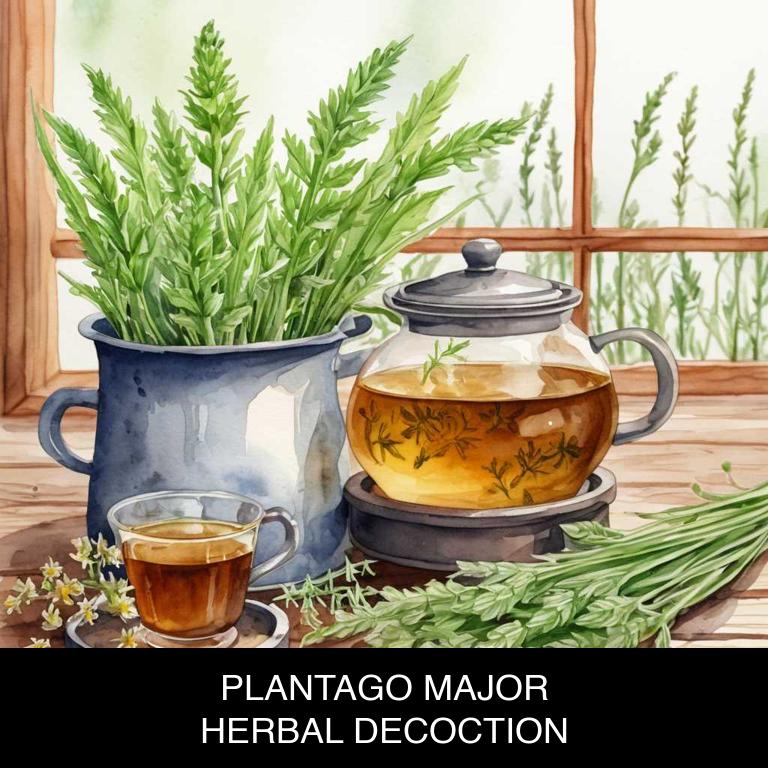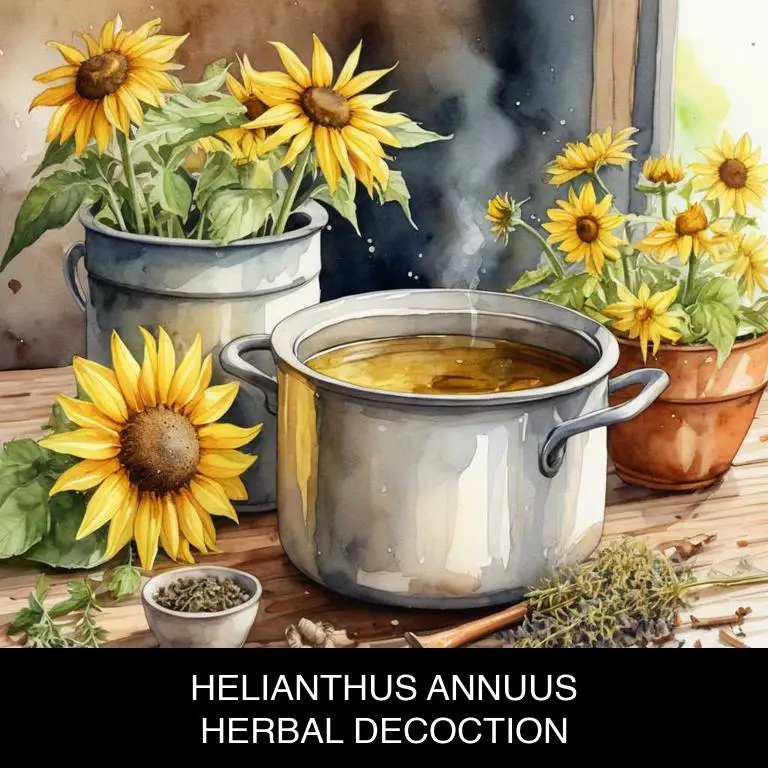By Leen Randell
Updated: Jul 04, 2024
10 Best Herbal Decoctions For Sunburn

Herbal decoctions for sunburn are a natural remedy that combines dried herbs with hot water to create a soothing liquid solution, helping to alleviate the discomfort and pain associated with sunburn.
These decoctions work by calming inflamed skin, reducing heat and redness, and promoting healing. Examples of herbal decoctions that can help with sunburn include chamomile, lavender, and calendula, which can be used as a cooling compress or bath soak.
By using these decoctions, individuals can find relief from the discomfort of sunburn and enjoy a faster recovery process, ultimately improving their overall quality of life.
The following article describes in detail the most important decoctions for sunburn, including medicinal properties, parts of herbs to use, and recipes for preparations.
- 1. Aloe vera
- 2. Calendula officinalis
- 3. Symphytum officinale
- 4. Plantago major
- 5. Hypericum perforatum
- 6. Urtica dioica
- 7. Taraxacum officinale
- 8. Helianthus annuus
- 9. Matricaria chamomilla
- 10. Echinacea angustifolia
- What is the best combination of herbal decoctions to use for sunburn?
- What ailments similar to sunburn are treated with herbal decoctions?
1. Aloe vera
Aloe decoctions helps with sunburn because it contains potent anti-inflammatory compounds like aloin and aloe-emodin.
These active ingredients help reduce inflammation and redness caused by sun exposure, providing quick relief from discomfort and pain. The cooling properties of the decoction also soothe and calm the skin, reducing heat and itching associated with sunburn. Additionally, aloe's antioxidant properties help repair damaged skin cells, promoting faster healing and regeneration.
Overall, aloe decoctions offer natural, effective relief for sunburned skin.

Medicinal Constituents
The list below shows the primary medicinal constituents in Aloe vera decoctions that help with sunburn.
- Glucomannans: These polysaccharides help soothe and calm sunburned skin by reducing inflammation and promoting skin hydration.
- Vitamins a, c, and e: These antioxidants help neutralize free radicals caused by UV radiation, reducing oxidative stress and promoting skin healing in sunburned areas.
- Anthraquinones: These compounds have anti-inflammatory and analgesic properties, which help reduce redness, swelling, and pain associated with sunburn.
Parts Used
The list below shows the primary parts of aloe used to make decoctions for sunburn.
- Leaves: Gel-rich inner layer: The most used part of Aloe vera for sunburn decoctions is the gel-rich inner layer of the leaves, as it provides soothing and cooling relief due to its high water content and anti-inflammatory properties.
- Leaves: Outer skin: The outer skin of the Aloe vera leaves is also commonly used, as it contains aloin, which helps to reduce inflammation and promote healing.
- Leaves: Juice: The juice extracted from the Aloe vera leaves is used in decoctions, as it contains vitamins, minerals, and antioxidants that help to soothe and calm sunburned skin.
Quick Recipe
The following recipe gives a procedure to make a basic aloe for sunburn.
- Chop 100g of aloe vera leaves into small pieces and discard the skin.
- Boil 500ml of water in a saucepan for 5-7 minutes on high heat.
- Add the chopped aloe vera to the boiling water and reduce heat to low.
- Simmer the mixture for 20-25 minutes or until the aloe vera is fully dissolved.
- Strain the decoction through a cheesecloth or a fine mesh into a clean container.
2. Calendula officinalis
Pot marigold decoctions helps with sunburn because of its potent anti-inflammatory and antioxidant properties.
The decoction's flavonoids and polyphenols work to soothe and calm irritated skin, reducing redness and swelling associated with sunburn. Additionally, the decoction's moisturizing properties help to hydrate and rejuvenate parched skin, promoting a faster recovery from sun damage.
As a result, pot marigold decoctions can provide effective relief for sunburn sufferers, easing discomfort and promoting a speedy return to normal skin health.

Medicinal Constituents
The list below shows the primary medicinal constituents in Calendula officinalis decoctions that help with sunburn.
- Triterpenoids: These compounds help with sunburn by reducing inflammation and promoting wound healing.
- Phenolic acids: These antioxidants neutralize free radicals that cause oxidative stress and skin damage, helping to soothe and protect sunburned skin.
- Flavonoids: These flavonoids exhibit anti-inflammatory and antihistamine properties, which help to reduce redness, itching, and swelling associated with sunburn.
Parts Used
The list below shows the primary parts of pot marigold used to make decoctions for sunburn.
- Flowers: They are the most commonly used part due to their high concentration of anti-inflammatory and antioxidant compounds.
- Leaves: They contain similar properties to the flowers and are often used as an alternative when flowers are not available.
- (optional) stems: While not as commonly used as flowers or leaves, the stems of Calendula officinalis can also be used for making decoctions due to their mild anti-inflammatory properties.
Quick Recipe
The following recipe gives a procedure to make a basic pot marigold for sunburn.
- Harvest 20-30 flowers from the calendula officinalis plant on a dry day at dawn.
- Dry the flowers in a low-temperature oven at 150 degrees fahrenheit for 30 minutes.
- Grind 2 teaspoons of dried flowers into a fine powder using a mortar and pestle.
- Combine the powder with 1 cup of boiling water and steep for 5-7 minutes.
- Strain the liquid through a cheesecloth and discard the solids for immediate use.
3. Symphytum officinale
Comfrey decoctions helps with sunburn because they possess anti-inflammatory and antioxidant properties that soothe and calm irritated skin.
The allantoin present in comfrey stimulates cell regeneration, accelerating the healing process of sun-damaged tissue. Additionally, its astringent properties help to reduce redness and itching associated with sunburn.
When applied topically as a decoction, comfrey's natural ingredients work synergistically to provide relief from pain, discomfort, and inflammation, promoting a faster recovery from sunburned skin.

Medicinal Constituents
The list below shows the primary medicinal constituents in Symphytum officinale decoctions that help with sunburn.
- Allantoin: It helps with sunburn by promoting wound healing and tissue repair through its anti-inflammatory and antioxidant properties.
- Flavonoids: They help with sunburn by reducing inflammation, scavenging free radicals, and protecting against oxidative stress.
- Saponins: They help with sunburn by exhibiting anti-inflammatory and antioxidant effects, which contribute to soothing and calming irritated skin.
Parts Used
The list below shows the primary parts of comfrey used to make decoctions for sunburn.
- Roots: The roots of Symphytum officinale are used due to their high mucilage content, which provides soothing and protective properties for sunburn relief.
- Leaves: The leaves are used because they contain bioactive compounds, such as flavonoids and saponins, which help to reduce inflammation and promote skin healing in sunburned skin.
- Flowers: The flowers of Symphytum officinale are used due to their anti-inflammatory and antioxidant properties, which aid in reducing redness and promoting the repair of damaged skin tissue in sunburn.
Quick Recipe
The following recipe gives a procedure to make a basic comfrey for sunburn.
- Harvest 25 grams of fresh symphytum officinale root or 50 grams of dried root material for decoction.
- Clean the root material by gently washing it with cold water to remove any dirt or debris.
- Combine the cleaned root material with 500 milliliters of water in a saucepan and bring it to a boil.
- Reduce the heat to a simmer and let it cook for 10 to 15 minutes to release the active compounds.
- Strain the decoction through a cheesecloth or a fine-mesh sieve into a clean container to remove the solids.
4. Plantago major
Plantain decoctions helps with sunburn because they contain anti-inflammatory properties that soothe and calm irritated skin.
The aloe-like gel within the plantain leaf has been shown to reduce redness, swelling, and discomfort associated with sunburns. Additionally, plantain's antioxidant properties help to neutralize free radicals caused by UV damage, promoting healthy cell regeneration and tissue repair.
By applying a cooled-down decoction of plantain leaves to affected areas, individuals can find relief from the discomfort and distress of sunburn.

Medicinal Constituents
The list below shows the primary medicinal constituents in Plantago major decoctions that help with sunburn.
- Phenolic acids: These compounds, particularly caffeic acid and ferulic acid, help with sunburn by reducing inflammation and oxidative stress, which can contribute to sunburn pain and redness.
- Saponins: These natural compounds have been shown to have anti-inflammatory and soothing properties, which can help to calm sunburned skin and promote healing.
- Flavonoids: Flavonoids, such as quercetin, have antioxidant properties that can help to protect the skin from damage caused by UV radiation, reducing the risk of sunburn and promoting skin health.
Parts Used
The list below shows the primary parts of plantain used to make decoctions for sunburn.
- Leaves: Their decoction is used to treat sunburn due to their anti-inflammatory and soothing properties.
- Roots: They contain compounds that can help reduce redness and promote skin healing.
- Stems: Their decoction is used for treating sunburn due to their potential to reduce inflammation and promote skin regeneration.
Quick Recipe
The following recipe gives a procedure to make a basic plantain for sunburn.
- Harvest plantago major leaves and flowers in the morning when they are at their highest moisture content.
- Chop 20 grams of the fresh plantago major herb into small pieces to increase surface area.
- Combine the chopped plantago major herb with 500 milliliters of water in a saucepan.
- Boil the mixture at 100 degrees celsius for 10-15 minutes to release its active compounds.
- Strain the decoction through a cheesecloth or a fine-mesh sieve to remove the plant material.
5. Hypericum perforatum
St John's Wort decoctions help with sunburn because of their anti-inflammatory and antioxidant properties.
The herbal concoction reduces redness, swelling, and pain associated with sunburned skin. It also soothes the affected area by calming irritated tissues and repairing damaged skin cells. Additionally, St John's Wort has natural analgesic properties that ease discomfort and itching caused by sunburn.
As a result, applying a cooled down St John's Wort decoction to the affected area can provide rapid relief from sunburn symptoms, promoting faster healing and minimizing the risk of further irritation.

Medicinal Constituents
The list below shows the primary medicinal constituents in Hypericum perforatum decoctions that help with sunburn.
- Naphthodianthrones: These compounds, particularly hyperforin and hypericin, help with sunburn by exhibiting photoprotective and anti-inflammatory properties, which can reduce redness and discomfort associated with sunburn.
- Flavonoids: Flavonoids present in Hypericum perforatum decoctions, such as quercetin and kaempferol, help with sunburn by acting as antioxidants, neutralizing free radicals that contribute to cell damage and inflammation caused by UV radiation.
- Phenolic acids: Phenolic acids, including caffeic acid and ferulic acid, help with sunburn by exerting antioxidant and anti-inflammatory effects, which can aid in the healing process and reduce the risk of secondary infections associated with sunburn.
Parts Used
The list below shows the primary parts of st john's wort used to make decoctions for sunburn.
- Leaves: Leaves are often used due to their high content of flavonoids, which have anti-inflammatory and soothing properties.
- Flowers: Flowers are commonly used due to their rich content of hyperforin and hypericin, which have antioxidant and anti-inflammatory effects.
- Buds: Buds are also used due to their high concentration of hyperforin and hypericin, which can help reduce inflammation and promote wound healing.
Quick Recipe
The following recipe gives a procedure to make a basic st john's wort for sunburn.
- Harvest 1 to 2 cups of fresh or dried hypericum perforatum flowers and leaves from a trusted source.
- Crush the harvested material into a fine powder using a mortar and pestle to increase its surface area.
- Combine 1 cup of the powdered hypericum perforatum with 2 cups of boiling water in a heat-resistant container.
- Steep the mixture for 10 to 30 minutes or 1 to 2 hours to allow for maximum extraction.
- Strain the decoction through a cheesecloth or a fine-mesh sieve into a clean container.
6. Urtica dioica
Stinging nettle decoctions helps with sunburn because of its potent anti-inflammatory properties.
When applied topically, the decoction reduces redness, swelling, and pain associated with sunburned skin. The antioxidants present in stinging nettle also help to neutralize free radicals caused by UV radiation, preventing further damage to the skin.
Additionally, the soothing and calming effects of stinging nettle can help to relieve discomfort and itching, promoting a faster recovery from sunburn.

Medicinal Constituents
The list below shows the primary medicinal constituents in Urtica dioica decoctions that help with sunburn.
- Apigenin: This flavonoid antioxidant helps with sunburn by reducing inflammation and protecting the skin from damage caused by UV radiation.
- Quercetin: As a potent polyphenol antioxidant, quercetin helps to neutralize free radicals and reduce inflammation, which can alleviate sunburn symptoms and promote skin recovery.
- Saponins: These natural compounds have anti-inflammatory and antiseptic properties, which can help to soothe and calm sunburned skin, reducing redness and promoting wound healing.
Parts Used
The list below shows the primary parts of stinging nettle used to make decoctions for sunburn.
- Leaves: The leaves are the most commonly used part due to their high concentration of anti-inflammatory and antioxidant compounds.
- Roots: The roots are used for their analgesic and anti-inflammatory properties, which help to soothe and calm sunburned skin.
- Stems: The stems are used for their ability to reduce inflammation and promote wound healing, making them effective in treating sunburned skin.
Quick Recipe
The following recipe gives a procedure to make a basic stinging nettle for sunburn.
- Harvest urtica dioica leaves and stems in the early morning after the dew has evaporated for best flavor.
- Rinse the harvested urtica dioica leaves and stems thoroughly with cold running water to remove dirt and debris.
- Chop the urtica dioica leaves and stems into small pieces using scissors or a sharp knife to release their medicinal properties.
- Combine 2 ounces of chopped urtica dioica with 32 ounces of boiling water in a saucepan and let steep for 10 minutes.
- Strain the urtica dioica decoction through a cheesecloth or a fine-mesh sieve into a clean container and discard the solids.
7. Taraxacum officinale
Dandelion decoctions helps with sunburn because they contain powerful antioxidants, such as flavonoids and phenolic acids, which help to neutralize free radicals that can cause inflammation and damage to skin cells.
The anti-inflammatory properties of dandelion also reduce redness and swelling associated with sunburn, while its soothing and calming effects ease discomfort and itching.
Additionally, the decoction's natural astringent properties help to dry up excessive sweating and promote healing by creating a protective barrier on the skin's surface.

Medicinal Constituents
The list below shows the primary medicinal constituents in Taraxacum officinale decoctions that help with sunburn.
- Saponins: Saponins in Taraxacum officinale may help soothe and calm sunburned skin, reducing inflammation and promoting healing.
- Flavonoids: Flavonoids, such as quercetin and kaempferol, in Taraxacum officinale may act as antioxidants, neutralizing free radicals and reducing oxidative stress caused by UV radiation.
- Taraxasterol: Taraxasterol, a triterpene in Taraxacum officinale, may have anti-inflammatory and antioxidant properties, helping to reduce sunburn pain, redness, and swelling.
Parts Used
The list below shows the primary parts of dandelion used to make decoctions for sunburn.
- Leaves: The leaves of Taraxacum officinale contain flavonoids and phenolic acids that have anti-inflammatory and antioxidant properties, helping to soothe sunburned skin.
- Flowers: The flowers of Taraxacum officinale contain flavonoids and other compounds that have anti-inflammatory and antioxidant effects, which can help to reduce redness and discomfort associated with sunburn.
- Roots: The roots of Taraxacum officinale contain inulin, a prebiotic that can help to soothe and calm sunburned skin, reducing inflammation and promoting skin health.
Quick Recipe
The following recipe gives a procedure to make a basic dandelion for sunburn.
- Harvest 20-30 fresh taraxacum officinale leaves and flowers for future use to ensure potency and freshness.
- Clean the harvested taraxacum officinale leaves and flowers thoroughly with cold running water to remove dirt.
- Chop the cleaned taraxacum officinale leaves and flowers into small pieces to increase surface area for infusion.
- Combine the chopped taraxacum officinale pieces with 2 cups of boiling water in a heat-resistant glass container.
- Steep the taraxacum officinale mixture for 5-7 minutes before straining the liquid through a cheesecloth to obtain the decoction.
8. Helianthus annuus
Sunflower decoctions helps with sunburn because of its unique combination of antioxidants, anti-inflammatory properties, and moisturizing agents.
The decoction's high concentration of vitamin E and beta-carotene soothes and calms red and inflamed skin, reducing discomfort and pain. Meanwhile, the astringent properties help to dry out any weeping blisters or rashes, promoting faster healing.
As a natural emollient, sunflower decoctions also hydrate and nourish the skin, leaving it feeling soft and supple.

Medicinal Constituents
The list below shows the primary medicinal constituents in Helianthus annuus decoctions that help with sunburn.
- Phenolic acids: They help reduce inflammation and oxidative stress caused by UV radiation, which contributes to sunburn symptoms.
- Flavonoids: These compounds have antioxidant properties that can neutralize free radicals and protect skin cells from damage, thereby alleviating sunburn symptoms.
- Saponins: Saponins can help soothe and calm sunburned skin by reducing inflammation and promoting wound healing.
Parts Used
The list below shows the primary parts of sunflower used to make decoctions for sunburn.
- Seeds: They are used to make decoctions for sunburn due to their anti-inflammatory and antioxidant properties.
- Leaves: They are used to make decoctions for sunburn due to their soothing and cooling effects on the skin.
- Roots: They are used to make decoctions for sunburn due to their ability to reduce inflammation and promote skin healing.
Quick Recipe
The following recipe gives a procedure to make a basic sunflower for sunburn.
- Harvest helianthus annuus flowers and leaves at dawn when the dew is still present for maximum potency retention.
- Dry the helianthus annuus flowers and leaves in a low-temperature oven at 150 degrees fahrenheit for 2 hours.
- Combine 20 grams of dried helianthus annuus flowers and 10 grams of dried helianthus annuus leaves in a stainless steel pot.
- Steep the helianthus annuus mixture in 1 liter of boiling distilled water for 15 minutes to release its bioactive compounds.
- Strain the decoction through a cheesecloth and discard the solids to obtain the final herbal extract.
9. Matricaria chamomilla
Chamomile decoctions helps with sunburn because of its anti-inflammatory and soothing properties.
The flavonoids and terpenoids present in chamomile have been shown to reduce redness, swelling, and pain associated with sunburned skin. When applied topically, the decoction can help calm irritated skin, reducing discomfort and promoting faster healing. Additionally, chamomile's antioxidant properties can help protect the skin from further damage caused by UV radiation.
As a result, incorporating chamomile decoctions into your skincare routine after sun exposure can provide relief and promote overall skin health.

Medicinal Constituents
The list below shows the primary medicinal constituents in Matricaria chamomilla decoctions that help with sunburn.
- Apigenin: An apigenin is a flavonoid that helps reduce inflammation and soothe skin irritation caused by sunburn, promoting faster healing and relieving pain.
- Α-bisabolol: α-Bisabolol is a sesquiterpene alcohol that provides anti-inflammatory and antioxidant effects, reducing redness, itching, and swelling associated with sunburn, while also promoting skin regeneration.
- Matricine: Matricine is a sesquiterpene lactone that exhibits anti-inflammatory and antioxidant properties, which can help reduce the severity of sunburn, soothe skin irritation, and accelerate the healing process.
Parts Used
The list below shows the primary parts of chamomile used to make decoctions for sunburn.
- Flowers: They are used due to their high content of apigenin and luteolin, which have anti-inflammatory and soothing properties that help to reduce sunburn pain and redness.
- Leaves: They are used because they contain flavonoids and terpenoids, which have antioxidant and anti-inflammatory effects that can help to calm and protect sunburned skin.
- Seeds: They are used due to their rich content of essential oils, particularly bisabolol, which has anti-inflammatory and soothing properties that can help to reduce sunburn pain and promote skin healing.
Quick Recipe
The following recipe gives a procedure to make a basic chamomile for sunburn.
- Harvest 10-20 fresh matricaria chamomilla flowers, clean them thoroughly to remove any dirt or debris.
- Weigh out 20-30 grams of dried matricaria chamomilla flowers or 40-60 grams of fresh flowers.
- Combine the weighed flowers with 1 liter of boiling water to create a decoction mixture.
- Reduce the heat to a simmer and let the decoction steep for 10-15 minutes to allow flavors to infuse.
- Strain the decoction through a cheesecloth or fine-mesh sieve into a clean glass container to remove solids.
10. Echinacea angustifolia
Kansas coneflower decoctions helps with sunburn because of its potent anti-inflammatory properties, which help reduce redness, swelling, and discomfort.
The decoction's flavonoids and phenolic acids work together to soothe the skin, calm irritation, and promote healing. Additionally, kansas coneflower has natural astringent properties that help reduce fluid loss and prevent peeling, allowing the skin to recover from sun damage more quickly and effectively.
As a result, using kansas coneflower decoctions can provide fast and effective relief for sunburned skin.

Medicinal Constituents
The list below shows the primary medicinal constituents in Echinacea angustifolia decoctions that help with sunburn.
- Cichoric acid: This is a type of phenolic acid that has anti-inflammatory and antioxidant properties, which can help reduce redness and swelling associated with sunburn.
- Iridoid glycosides: These compounds have been shown to have anti-inflammatory and antioxidant effects, which can help soothe and protect the skin from further damage after a sunburn.
- Alkylamides: These are a type of terpene that have anti-inflammatory and immunomodulatory effects, which can help reduce the severity of sunburn and promote skin healing.
Parts Used
The list below shows the primary parts of kansas coneflower used to make decoctions for sunburn.
- Roots: They contain compounds that help to soothe and calm sunburned skin, reducing inflammation and promoting healing.
- Leaves: They have anti-inflammatory and antioxidant properties that can help to cool and protect the skin from further damage caused by sunburn.
Quick Recipe
The following recipe gives a procedure to make a basic kansas coneflower for sunburn.
- Harvest 20-30 fresh roots of echinacea angustifolia in the fall after the first frost.
- Clean and dry the roots by air-drying them for 2 weeks or using a dehydrator.
- Chop the dried roots into small pieces using a sharp knife or a mortar and pestle.
- Combine 1 part dried root material with 4 parts water in a large pot and simmer.
- Steep the decoction for 10-20 minutes and then strain it through a cheesecloth or fine-mesh sieve.
What is the best combination of herbal decoctions to use for sunburn?
The best combination of herbal decoctions that help with sunburn is a soothing blend of aloe vera, calendula, and chamomile.
Aloe vera helps to calm and hydrate the skin, while calendula reduces inflammation and promotes healing. Chamomile adds a calming effect, reducing redness and itching. To make this decoction, combine equal parts of dried aloe vera, calendula, and chamomile in boiling water, then let it steep for 5-7 minutes.
Strain and apply the cooled decoction to the affected skin for relief from sunburn.
What ailments similar to sunburn are treated with herbal decoctions?
Ailments similar to sunburn/decoctions.html">sunburn/decoctions.html">sunburn that are treated with herbal decoctions are skin conditions characterized by inflammation, redness, and itching.
Herbal remedies like aloe vera, chamomile, and calendula have anti-inflammatory properties that soothe irritated skin, reducing pain and discomfort.
Decoctions made from these herbs can be used to treat minor burns, eczema, acne, and rosacea, providing natural relief and promoting healthy skin regeneration.